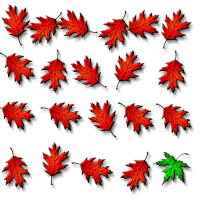Generalization
Note: Glossary links are in boldface.
If the learning of knowledge is to be applicable to problem-solving and creative thinking, the concepts must generalize to novel examples and not generalize to novel non-examples. The ultimate test of any strategy to teach concepts is in the application of the concepts to new stimuli.
Operations to Induce Generalization
Engelmann and Carnine (1991) describe three processes involved in the induction of generalization: interpolation, extrapolation, stipulation,
Interpolation: Concept Definition
Interpolation involves treating examples of a concept that lie along a continuum in the same way. For example, imagine the following continuum of brightness.

Now imagine that the learner is told:
- Item 2 is an example of "Blet."
- Item 4 is an example of "Blet."
- Item 7 is an example of "Blet."
The process of interpolation would lead a learner to generalize to the interspersed items 3, 5 and 6. That is, items that are intermediate among examples are interpreted as being examples.
Extrapolation: Concept Definition
Extrapolation involves treating large differences as being at least as important as small differences So, if a small change results in an example becoming a non-example, then by extrapolation, a large difference will also result in the item being a non-example. Let's use a visual example to illustrate this.

Imagine that the smaller butterflies in this collection were all examples of the concept "Min" and that the medium-sized butterflies were "not Min." Through extrapolation the learner would likely come to the conclusion that the largest butterflies were also "not Min."
Extrapolation limits undue generalization since more extreme non-examples along any particular quality dimension are not essential for the formation of the concept.
Stipulation: Concept Definition
Stipulation involves the presentation of many examples that are highly similar and treating them in the same way. Repeated examples within a limited range suggest to the learner that most of the qualities present in the examples are critical to the definition of the concept.

Let's try an example. Imagine that the 21 leaves in this figure were presented one-by-one, from left to right and from top to bottom. If the first 20 were all treated in the same way, for example by the teacher labeling each of them as "oak leaf," the learner might respond to leaf 21 as "not oak leaf" through the process of stipulation.
Stipulation allows us to show a range of positive examples of a concept, and to introduce non-examples with an increased tendency for the learner to correctly recognize the limit of the concept.